This article is written by Vanya Verma from Alliance University, Bengaluru. This article talks about how an individual can file a complaint against illegal transportation and smuggling of animals as well as how a case is registered against the same along with a sample.
Table of Contents
Introduction
The significance of wildlife must be viewed in light of the constitutional mandate. The Directive Principles of State Policy in the Indian Constitution include the protection and improvement of the environment, as well as the preservation of forests and wildlife (Article 48A). Every citizen has a fundamental duty to safeguard and improve the natural environment, including forests, lakes, rivers, and animals, as well as to have compassion for living creatures, as per Article 51A(g) of the Constitution. The Concurrent List, (List-III), Seventh Schedule of the Constitution of India includes animal cruelty prevention, forests, and (protection) of wild animals and birds.
Taking, possession, trading or movement, processing, or consumption of wild animals and plants or their derivatives in violation of any international, regional, or national legislation is referred to as wildlife crimes. Cruelty to wild animals, both free-living and captive, and persecution of them are sometimes included in this definition. Despite the fact that wild animals and plants are the primary victims of wildlife crime, it has a cascading effect on the ecosystem of a given country or region. Wildlife is our national wealth, as stated in the Constitution. As a result, wildlife crimes have become a problem in the country. Because illicit wildlife trade involves large sums of money, it should be considered a major economic crime.
The main wildlife offences are hunting and unlawful trafficking. All other offences, including preparation, possession, transportation, processing, and so on, are considered ancillary offences. As a result, wildlife offenders can be divided into two categories, firstly poachers or hunters who kill or capture wild animals or collect wild plants, and secondly, people who buy hunted and/or captured animals, body parts or derivatives, or collected plants, parts or derivatives, for personal consumption or trade. Wildlife material traders are the most powerful group of wildlife criminals, and they act in a well-organized manner. Organised wildlife criminal networks exist throughout the world, and they profit handsomely from their crimes.
Poaching is frequently linked to various levels of violence. Poachers for ivory, rhino horns, and other valuables have traditionally relied heavily on armament, which can result in human bloodshed. Poaching of other species, such as snakes, orchids, turtles, and so on, is more reliant on technical skills to identify high-value species. Poachers in India are frequently compelled by poor socio-economic conditions.
Procedure to file a complaint against illegal smuggling or transportation of animals
The steps below will assist you in registering a complaint:
Registering a case
Different states give different names to an offence report. Some examples are a Preliminary Offence Report, an Offence Report, a First Information Report (FIR), and a Seizure Notification. These are known as wildlife offence reports, and they are used to standardise the reports. The reports are prepared under Section 50(4) of the Wildlife (Protection) Act, 1972. Animal welfare organisations and individuals can file a report in India if they witness illegal smuggling or transportation of animals.
Here are few simple steps you need to follow:
- Keep a safe distance and defend yourself if you believe you are seeing a crime in progress.
- If it is safe to do so, use your cell phone to record images or videos.
- Make a list of any information you have on the offender, including any vehicle information, what you saw, and where the incident occurred.
- Include the full website URL and screen captures of the possible unlawful sale if you suspect someone is trafficking wildlife online.
Submitting a complaint in support of animal rights
If you wish to submit a “complaint”, you’ll need to go to a magistrate. A complaint can be made orally or in writing. A forest officer can be approached, and a complaint can then be filed with the magistrate. The following people can submit a complaint with the magistrate under Section 55 of the Wildlife (Protection) Act, 1972:
- Members of the Central Zoo Authority or Member – Secretary of the Tiger Conservation Authority, Director of the concerned Tiger Reserve, or any other officer approved by the Central Government on his behalf.
- The Chief Wildlife Warden is in charge of protecting wildlife.
- Any person who has given at least sixty days’ notice to another person or organisation of his intention to file a complaint.
Arrest by an individual
The offences are non-bailable and cognizable under the Wildlife Protection Act. An individual can arrest an offender who has committed a non-bailable and cognizable offence under Section 43 of the CrPC. Also, when someone who is a habitual offender hands him/her over to the police.
Contact WCCB or TRAFFIC India
Please notify the Wildlife Crime Control Bureau (WCCB) and TRAFFIC India if you come across any information on the illegal wildlife trade in the:
- Forest or police officers in the area.
- At airports, seaports, and other international transit points, customs officials.
|
Authority |
Address |
Contact details |
|
Wildlife Crime Control Bureau (WCCB) |
Trikoot-I Bhikaji Cama Place, New Delhi |
Tel: (+91-11) 26182484 Fax: (+91-11) 26160751 |
|
TRAFFIC India Office C/o WWF-India |
172-B, Lodi Estate New Delhi 110003 |
(+91-11) 41504786/43516290 Website: www.trafficindia.org; www.traffic.org Email: [email protected] |
Contact the regional offices of Wildlife Crime Control Bureau
List of the offices of Wildlife Crime Control Bureau
|
Office |
Address and contact details |
States/UTs covered |
|
BHQ |
Additional Director, Wildlife Crime Control Bureau, 2nd Floor, Trikoot – 1, Bhikaji Cama Place, New Delhi -110066. Telephone: 011 – 26182483 – 85 Fax: 011 – 26160751 |
All India Jurisdiction |
|
Northern Region |
Regional Deputy Director, Wildlife Crime Control Bureau / Northern Region, Bikaner House, Shahjahan Road, New Delhi- 110 011. Telefax: 011 – 23384556 |
Haryana, Himachal Pradesh, Rajasthan, Uttarakhand, Uttar Pradesh, Jammu & Kashmir, Panjab, Delhi. |
|
Eastern Region |
Regional Deputy Director, Wildlife Crime Control Bureau / Eastern Region, Nizam Palace, 2nd MSO Building, 6th Floor, A.J.C Bose Road, Kolkata-700020. Telefax: 033 – 22878698 |
Assam, Bihar, Meghalaya, Manipur, Mizoram, Nagaland, Sikkim, Tripura, Arunachal Pradesh, West Bengal |
|
Central Region |
Regional Deputy Director, Wildlife Crime Control Bureau / Central Region, R.F.R.C Mandla Road, T.F.R.I. Campus Jabalpur- 482021. Telefax: 0761 – 2840689. |
Chattisgarh, Jharkhand, Madhya Pradesh, Odisha. |
|
Western Region |
Regional Deputy Director Wildlife Crime Control Bureau/ Western Region, Room No.501/B, Vth Floor, Kendriya Sadan Building, CBD Building, Belapur, Mumbai-4000614 Telefax: 022 – 26828184 |
Goa, Gujarat, Maharashtra, Daman & Diu, Dadar & Nagar Haveli. |
|
Southern Region |
Regional Deputy Director Wildlife Crime Control Bureau / Southern Region, C2A, Rajaji Bhavan, Besant Nagar, Chennai-600090. Telephone: 044 – 24916747 Fax: 044 – 24463477 |
Andhra Pradesh, Karnataka, Tamil Nadu, Kerala, Puducherry and Andaman & Nicobar Islands. |
Basics of registering a complaint
Offences unnoticed by forest officers
Section 55(c) of the Wildlife (Protection) Act, has a provision that allows activists to pursue offences that have gone unnoticed by forest officers. A notice under Section 55(c), accompanied with details and evidence (pictures, videos, and reports), can be sent to the State Chief Wildlife Warden. If no action is taken within 60 days, you can submit a complaint with the Jurisdictional Magistrate, who can take cognizance of the case and begin a criminal trial against the offender(s).
Cases of hunting and smuggling
Several law enforcement agencies have the authority to take action in cases of hunting and smuggling. Local police, the District Superintendent of Police’s Crime Branch, the CID Forest Cell of the Police, the Forest Department’s Forest Mobile Squad and Vigilance Wing, and the Wildlife Crime Control Bureau are among them. If you don’t trust local forest department officials to act honestly, you could approach any of these.
Documenting violations
Please gather as much evidence as possible if you see a suspected infringement in the field. Take wide-angle and close-up photographs and movies. Find out the specific local name of the site, if feasible a GPS reading, the name of the Range, Beat, or Compartment, and a conspicuous landmark (river/watchtower/waterhole, etc.). Not only will your complaint be taken more seriously, but the information you provide will also improve detection and investigation.
Filing a petition
Please ensure that you first issue a notice/memorandum to the relevant or statutory authority seeking action before filing a petition with the High Court or the National Green Tribunal (NGT). If that doesn’t work, file the petition and include a copy of the notice that has been acknowledged. This will protect your petition from being dismissed or disposed of on this basis, as courts now check to see if administrative remedies have been exhausted.
Complaint and charge sheet
Complaint cases are the most common type of case under the Wildlife Act. A complaint is an allegation filed to a Magistrate by an official under Section 55(b) of the Wildlife Act or a citizen under Section 55(c) of the Wildlife Act or under Section 200 of the CrPC to initiate criminal proceedings. A police complaint is essential “Information” concerning an offence that is filed as an FIR. It is not permitted to file a charge sheet or Police Report.
Obtain a copy of the PA Notification in its official form
The government publishes all Protected Area (PA) notices in the Official Gazette. You can download and analyse PA notices that are of interest to you. Because a PA may contain numerous Reserved Forests (RF), certified copies of the RF Notifications may be required to fully comprehend the various legal rights that have been documented and granted. Footpaths or roads, settlements/villages, places of worship, water or forest produce, and so on are examples of such rights.
Check for encroachments using satellite imagery
Google Earth is a fantastic tool for tracking forest encroachment. This is a free utility that may be downloaded from the Google Earth website. It’s easy to use and can assist you in determining whether any forests have been destroyed or current settlements have grown. You can also collect imagery from earlier years and compare it to what is happening now. The newly encroached area can also be measured. In a court of law, time-series satellite images can be used as evidence.
Meeting with Government Officials
Here’s a little-known fact regarding interacting with the government: Make a note of the time, date, and location whenever you meet with an official, whether in his or her office or out in the field. Make it a point to accurately quote any discussion or assurance you may have received, as well as the meeting date and other pertinent information, in any letter or reminder you send. The meeting/interaction will be noted in government records as a result of this.
Filing RTIs
Always request a ‘Certified Copy’ when filing an RTI. Obtaining a Certified Copy will come in handy, especially if you need to file it in court or distribute it to the press. The document will be considered genuine. So, the next time you approach the Public Information Officer (PIO), make sure to write “Certified Copy” (rather than “Copy”) in column 3 of the RTI form.
Registration of cases
In conventional crimes, the investigation begins with the filing of a First Information Report (FIR). Material evidence (stolen items, guns, vehicles, and so on) is only recovered once the case has been registered. In wildlife crime cases, however, the seizure of wildlife/wildlife articles or the arrest of the accused/suspect may occur before the complaint is filed. In other words, in wildlife offences, an authorised officer who makes a seizure or arrest may file a seizure/apprehension report or an offence report in the jurisdictional court. This report is known by several titles in different states, including Preliminary Offence Report (POR), H-2 Case, Offence Report, First Information Report (FIR), Seizure Intimation, and so on. However, some judicial officers who are unfamiliar with wildlife crime cases have expressed doubts about the validity of such allegations and have insisted on filing an FIR/POR.
In rare cases, jurisdictional courts have refused to accept such reports since they are not on par with the First Information Report (FIR) filed by the police. To prevent such technical issues and to ensure consistency in practice, it is proposed that the first report filed in a jurisdictional court in instances involving wildlife crimes be referred to as the Wildlife Offence Report (WLOR). Wildlife Offence Report is prepared under Section 50(4) of the Wildlife (Protection) Act, 1972. The following is a standard format for a Wildlife Offense Report.
Checklist for preparing Wildlife Offence Report (WLOR)
- Each WLOR shall be issued a serial number that is kept track of year to year (e.g., WLOR No. 1/2012 of _____, dated___________, Forest Range, Division/TRs).
- The WLOR should include the date and time of receiving information at the Forest Range or the detection of the infraction.
- Only the standard format should be used for WLOR.
- The WLOR should be duly filled.
- Correct legal sections should be used.
- All known accused/ suspects’ current and permanent addresses, parentage, age, sex, and other information must be included in the WLOR.
- If the accused/suspects are not known, the same should be mentioned in the WLOR.
- If there are any unknown offenders, the words “and other unknown offenders” shall be added following the list of known offenders.
- The WLOR’s information section should be written in plain English with no ambiguity. It should give adequate reasons for the accused to be prosecuted.
- The information section shall include information on the wildlife involved, including common and scientific names, the Schedule under which the animal is listed in the WL (Protection) Act, the amount of punishment for the offence, and so on.
- The Investigating Officer’s name and position, as well as the officer who made the seizure and the officer who prepared the WLOR, shall all be noted in the WLOR.
- There should be no delay in filing the WLOR. If a delay occurs due to unusual circumstances, the reasons for the delay should be explained in the WLOR.
- A copy of the WLOR should be transmitted as soon as possible to the immediate supervisory officer, the CWLW, or any other officer authorised by him. This is required so that the immediate supervisory officer is aware of the commission of the offence under his jurisdiction and can advise/monitor the investigation’s progress.
Registration of FIR and investigation of offences under the Wildlife (Protection) Act, 1972, by a police officer
Since violations of the provisions of the Act are not defined as cognizable offences, police officers are often not willing to file a complaint and investigate offences recorded under the provisions of the Act. Offences against other laws that are punishable by imprisonment for three years or more are classified as cognizable under Part II of Schedule I of the Criminal Procedure Code, 1973. The majority of the offences under the Act are punishable by three years or more in jail. As a result, an officer in charge of a police station is required to file an FIR and investigate the case as if it were any other criminal offence.
Courts, on the other hand, will only take cognizance of any violation of the Act if a complaint is filed by a person named in Section 55 of the Act. As a result, if police officers in the affected state are not authorised to file complaints under Section 55 of the Act, the Police report must be submitted to the court as a complaint via an authorised forest officer. No additional inquiry will be performed without the court’s permission once a complaint has been lodged. Furthermore, after a complaint has been filed, there is no possibility for submitting a supplementary complaint. As a result, each subsequent discovery, seizure, arrest, or other action will be treated as a new case and filed as a separate complaint in court.
Sample of Wildlife Offence Report (WLOR)
|
1. Name of the Forest Range and Division: 2. WLOR number and date: 3. Place of detection/seizure: 4. Date on which the offence was detected or the seizure affected: 5. Details of articles seized: 6. Nature of the offence and Sections of law: 7. Name, parentage and full residential address of the accused/suspects: 8. Whether the accused/suspect was arrested, if so, by whom: 9. Place and time of arrest of the accused/ suspect: 10. Names and addresses of independent witnesses, if any: 11. Whether intimation was given to the Chief Wildlife Warden or the authorised officer: 12. Where or in whose custody the seized properties are kept/detained: 13. Details of the incident/offence reported: Name & Designation of the officer sending the Offence Report to the Court Enclosures 1. Original Search and Seizure Memo in ____pages. 2. Arrest cum Personal Search Memo in ____pages. 3. Confession Statement of the accused in ______pages. 4. Crime Scene Inspection Memo, photographs and sketch map of the scene of the crime. 5. List of properties seized with markings forwarded to the Court. To The Chief Judicial Magistrate/JMFC (Place & address) Copy to : 1. The Dy. Conservator of Forests______ 2. The Conservator of Forests__________ 3. The Chief Wildlife Warden, __________State 4. The Additional Director, WCCB, New Delhi |
Conclusion
Ultimately the customer is the final player in the fight against illegal wildlife trading. Poaching could be eradicated if they stop buying wildlife items. TRAFFIC supports this attitude and has initiated programs to raise awareness about illegal wildlife trafficking and reduce demand.
The latest public service campaign from TRAFFIC, WANTED ALIVE, reminds people that large cats are “Wanted Alive” in their native environment! The four Asian big cats — Tiger, Leopard, Snow Leopard, and Clouded Leopard— are all threatened by unlawful trading in their body parts, according to campaign posters. To combat poaching and illegal trafficking in the country and region, TRAFFIC constantly collaborates with trustworthy and reputable agencies such as the CBI, Police, Forest Departments, Wildlife Crime Control Bureau (WCCB), Wildlife Institute of India, The National Tiger Conservation Authority (NTCA), South Asia Wildlife Enforcement Network (SAWEN), and the International Criminal Police Organization (INTERPOL), among others. TRAFFIC is dedicated to preventing poaching and criminal trading in protected species, as well as ensuring that legal commerce in medicinal plants and wood species is maintained at sustainable levels. All of its programs are aimed at achieving this, which is possibly one of the most difficult objectives of the twenty-first century.
References
- https://www.legalserviceindia.com/legal/article-1410-illegal-trafficking-and-poaching-laws-in-india.html
- https://www.ecohealthalliance.org/2017/10/7-ways-you-can-help-stop-the-illegal-wildlife-trade
- https://www.fws.gov/midwest/news/ReportWildlifeCrime.html
- https://pib.gov.in/PressReleseDetailm.aspx?PRID=1693569
- https://www.conservationindia.org/tips
- http://wccb.gov.in/WriteReadData/userfiles/file/Wildlife%20Crime%20Investigation%20Manual.pdf
- http://awsassets.wwfindia.org/downloads/traffic_panda_8_oct.pdf
LawSikho has created a telegram group for exchanging legal knowledge, referrals, and various opportunities. You can click on this link and join:
 Serato DJ Crack 2025Serato DJ PRO Crack
Serato DJ Crack 2025Serato DJ PRO Crack











 Allow notifications
Allow notifications



